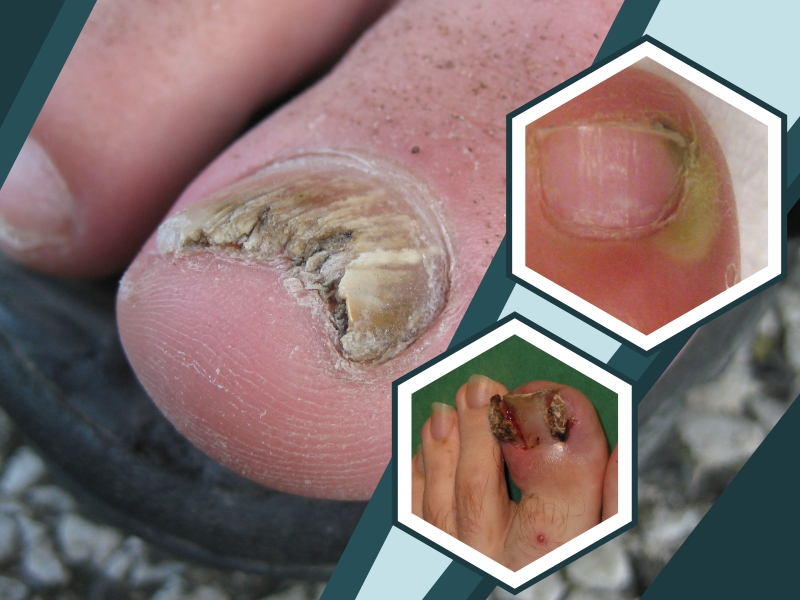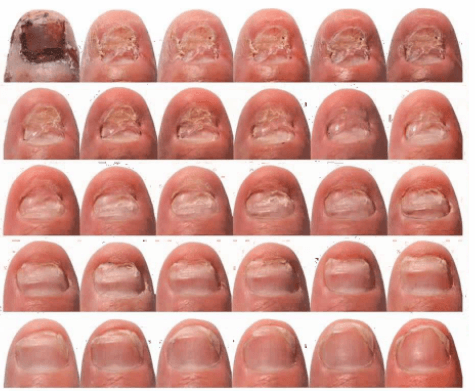Fungal Nail Infection: Symptoms, Types, Risk Factors, Causes, and Treatment

Fungal nail infection is one of the most common infections of the nail. It begins as a yellow-brown or white spot that appears under the tip of your nail. As time passes, the nail might change color, thicken, and then break near the edge. Nail fungus can affect several nails. Fungi may be found in soil, air, plants, and our bodies. Fungi can be beneficial or harmful, like other microbes.
Types Of Fungal Nail Infection
- The subungual onychomycosis can be lateral or distal. It is the most prevalent type. It’s caused by a fungus known as a dermatophyte. It can be found on your toenails or fingernails. It starts inside the nail bed, beneath the nail. It’s a yellowish area that extends across the edges of your nail towards the center and the places it breaks away from the nail bed.
- White, superficial onychomycosis. It is not as common and only affects the nail’s surface, mostly around your fingernails. The first signs are white spots that turn dry and cause the nail to crack.
- Proximal subungual onychomycosis. It is first seen as white spots in the middle of the nail bed, near the cuticle. They expand as the toenail or finger expands. It’s not common and typically is seen in people with issues with their immune system, such as HIV infection.
- Candidal onychomycosis. The yeast that causes this infection generally affects the fingernails. The nail area is usually inflamed and swollen, and the nails could disappear completely. It is common for nails to be damaged due to an injury or a different infection.
Signs and Symptoms of Fungal Nail Infection

- Nails with thickened nails
- Nails with discoloration
- Crumbly, crumbly, or rough
- Misshapen nails
- Separated from the nail bed
- Smelly
See your doctor if you experience:
- If you have diabetes, you may be developing a nail fungal infection
- Nail bleeding
- Pain or swelling around the nails
- Walking is difficult.
Risk Factors Of Fungal Nail Infection
A serious nail fungus condition could be painful and result in permanent nail damage. Factors that could increase the risk of developing nail fungus are:
- Older age
- Shoes that cause your feet to sweat very much
- A history of an athlete’s foot in the past
- Untidy walking in areas with damp conditions, such as fitness centers, pools, and shower rooms.
- A minor skin or nail injury
- Being afflicted with a skin disease that affects your nails, like psoriasis,
- Being diagnosed with issues with blood flow or a deficient immune system
What Causes Fungal Nail Infection?
The cause of the infection is different organisms. The most prevalent is known as Dermatophyte. Bacteria, yeast, and mold can also result in nail infection. The discoloration caused by an infection caused by bacteria tends to be black or green. It may be spread to the nail, and fungal infections of the nail may spread to the feet. It is also possible to get the infection by touching areas where fungi thrive, such as the floor tiles in a gym shower or inside sweaty, dark, and moist shoes.
Treatment, Management, and Prevention of Fungal Nail Infection

- Clean your feet and hands frequently. Wash your hands immediately after touching a nail that is infected. Dry them well, and apply antifungal foot powder and moisturizer to your nails.
- Try applying a nail softener that can assist in strengthening the cuticles and nails.
- Straighten nails, smooth out the edges using a file, and then file the thickened areas. Make sure to clean your nail clippers following every use. Allowing your nails to grow long gives more opportunities for fungus to thrive.
- Change your socks with absorbent socks, or wear absorbent ones. Your socks during the day.
- Select shoes made of substances that allow air to circulate.
- Please remove old shoes, or treat them with antifungal or disinfectant powders.
- Pick a salon that employs sterilized manicure equipment for each client. Also, disinfect the tools you use to do your manicures at home.
- If you suffer from an athlete’s foot, treat it using an antifungal medication.
Medication Used for Fungal Nail Infection
Terbinafine tablet. This tablet treats fungal diseases of nails and fingernails. Terbinafine is part of a group of drugs known as antifungals. It stops the growth of the fungi.



